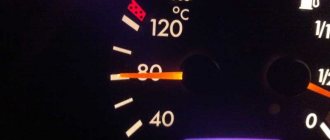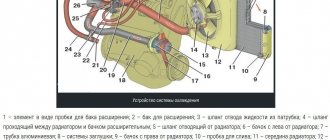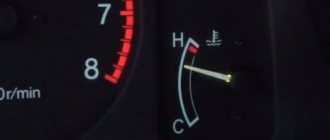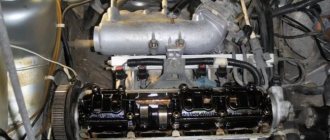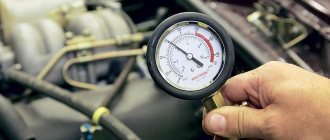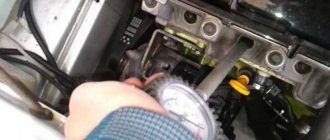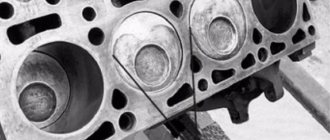For a car, the operating temperature of the engine, depending on the type of engine: gasoline or diesel, it may differ. Knowing the correct indicators, you can conclude whether the engine is working properly, and understand whether the temperature is too low or high.
In gasoline versions, the operating temperature of the engine in the combustion chamber can rise to 2000 degrees, this is considered normal: only in this way will the fuel mixture burn optimally, giving the greatest power. However, to normalize the temperature, each car is equipped with a cooling system; it is needed to maintain 90 degrees, otherwise all liquids will begin to boil. Some models work normally at 110 degrees. Usually these are old-style designs, equipped only with air cooling.
If the temperature is optimal, the cylinders will work better, the engine will last longer, and will start stably. When heated, many elements can expand, so special thermal gaps are designed for them. When parts overheat, they close the permissible gaps, friction becomes stronger, some elements may stop moving, and then the motor will jam. Less dangerous phenomena are minor breakdowns, the formation of gaps in the cylinders, due to which their power decreases, and the cylinders are poorly filled. The fuel may begin to detonate on its own at the wrong moment, leading to structural failure.
Optimum temperature of a warm engine
When fuel mixtures burn in the cylinders, a huge amount of heat is released. In combustion chambers the temperature reaches +2000 °C or more. That is why the design of power units necessarily includes a cooling system, the elements of which remove heat from the working units.
The cooling system allows you to maintain the optimal operating temperature of the engine – +80-90°C. In certain types of power units, these standards are expanded to +110°C (most often these are air-cooled mechanisms).
When the engine operates in the above thermal range, the best conditions are created for the complete filling of the cylinders with the air-fuel mixture and stable operation of the engine.
Experts admit that movement can begin already at a temperature of about +50 ° C. At the same time, before reaching operating mode, you should not load the engine too much.
Power units of modern cars reach this value in 3-5 minutes. However, you shouldn’t focus entirely on time. It is very important to rely on your own feelings. For example, pay attention to the stove: if you feel that the air flow coming from it is already cold, but the cabin has become significantly warmer, it means that the engine has reached operating temperature. The exception is for machines with an electric heater. Its operation does not depend in any way on the engine temperature.
Gasoline engine operating temperature
The operating temperature of gasoline power units – both carburetor and injection – should not exceed +90 °C. Heating above +130°C is dangerous for such engines - there is a risk of some elements jamming.
Too high operating temperatures indicate problems in the cooling system - most likely, the level of antifreeze is too low (this happens as a result of its boiling, evaporation, leaks). If this issue is not resolved in time, under the influence of high temperatures the parts will begin to deform and expand in volume, the engine may fail and require expensive overhauls.
Diesel engine operating temperature
The optimal operating temperature of a diesel engine is +70… +90 °C. The permissible maximum for power units operating under increased loads is +97 °C.
Maintaining this thermal regime is a necessary condition for the optimal functioning of vehicle mechanisms and systems. The operating principle of a diesel engine is different from that of a gasoline engine. The fuel mixture is not prepared in advance. Air enters the chamber first. With strong compression it heats up to +700 °C. At the moment of fuel injection, an “explosion” occurs, followed by uniform combustion of the resulting mixture. As a result, the piston moves to the bottom “dead” point.
The temperature in a diesel engine depends on the type of engine, the ignition delay period of the air-fuel mixture, the quality and uniformity of fuel combustion.
Main types of internal combustion engine cooling systems
- Natural type air system. It is still used in mopeds and inexpensive motorcycles.
- Forced air system . For more efficient cooling, an additional electric fan is used.
- Open type liquid cooling. It is used in river and sea vessels where it is possible to replenish with cold water.
- Closed-loop liquid cooling . Used in most modern cars with internal combustion engines.
Reasons for rising temperature
Structurally, the engine has thermal clearances, since parts are subject to expansion when heated. If the temperature of the power unit rises above permissible values, the clearances are violated, which causes intense wear, scuffing and various types of breakdowns. In addition, there is a decrease in engine power due to deterioration in cylinder filling, as well as the appearance of detonation and self-ignition of the fuel.
Overheating can occur due to:
- Thermostat valve stuck closed
- Malfunction of the electric radiator cooling fan (breakage of the electric motor, blown fuse, failure of the temperature sensor or fluid coupling)
- Radiator contamination
- Malfunction of the valve in the expansion tank cap
- Cylinder block gasket failure
- Pump leaks
- Loss of tension or breakage of the drive belt of additional mechanisms
- Depressurization of the cooling system
What to do when antifreeze and antifreeze boil in the system
When the antifreeze boils, thick white smoke comes out from under the hood, and the temperature indicator on the dashboard shows more than +100 °C. To avoid serious consequences, you must immediately take the following steps:
- We remove the load from the engine, for which we select neutral gear and let the car coast without turning off the engine.
- We turn on the heater to cool the coolant faster.
- We turn off the engine as soon as the car comes to a complete stop, but do not turn off the heater.
- Open the hood for better airflow into the engine compartment and wait about 30 minutes.
After completing the procedures, there are two options for solving the problem:
- find and fix the fault on your own, if this can be done on the road and you understand cars;
- call a tow truck.
If it is not possible to repair the car or call a tow truck, you need to move to the nearest service station with breaks for the coolant to cool.
Reasons why the engine does not warm up to operating temperature
Incomplete warming up of the engine is just as undesirable as overheating. If fuel comes into contact with the cold cylinder walls, it condenses and enters the crankcase, diluting the oil there. This leads to intense wear of both the CPG and other friction pairs: the crankshaft journal, liners, camshaft bed, intermediate and balancer shafts, etc.
In addition, when the power unit is not warmed up (especially in winter) during short distance trips, oil additives practically do not work and do not perform their functions.
When the engine temperature is too low, the oil is thicker and penetrates the parts less well, causing wear, increased fuel consumption, and a decrease in the power of the power plant.
Possible causes of too low engine operating temperature may be:
- Thermostat valve stuck open
- Frequent trips over short distances
- A thermostat or temperature sensor that is “colder” than prescribed by the manufacturer
What causes engine overcooling?
The phenomenon of hypothermia also negatively affects the quality of operation of the power unit. Most often this happens in winter or when operating a vehicle in difficult climatic conditions of the far north.
The operating temperature of the engine in winter can be sharply reduced while the car is moving. At the same time, flows of cooled air blow over the radiator and the entire power unit. As a result, the coolant sharply lowers the engine temperature, even if it is running at full load.
Consequences of exceeding engine operating temperature
First of all, an increase in temperature in the engine leads to intense boiling and evaporation of the coolant. As soon as cooling stops, the temperature of the power unit begins to rise even faster.
Overheating of the engine leads to a change in the properties of the metal and its expansion. Parts begin to deform and change their normal dimensions, which leads to their jamming.
At ultra-high temperatures, the thermal gaps between the metal elements of the power unit are disrupted, which causes the following negative consequences:
- Accelerated wear of working units
- Deformations and breakdowns of mechanisms
- Reducing engine power
- Occurrence of detonation
- Unauthorized ignition of fuel
What is modern car antifreeze?
Antifreeze is a non-freezing mixture. Antifreeze is also often used in heating systems.
You can find many types of antifreeze on the market, the main components of which are solutions based on a mixture based on chemical additives: you can also purchase full-fledged compositions based on polyhydric alcohols for your car.
- To obtain high-quality antifreeze, it is necessary (almost always) to add additives that make the above mixture more reliable for the heating system itself.
- A secondary useful characteristic of the refrigerant is its low freezing point and high boiling point (this will be discussed in the article).
- The latest antifreezes include various types of additives for high-quality cooling of a car engine.
In general, this refrigerant is made on the basis of several types of atomic alcohols, including antifreeze made on the basis of ethylene glycol or propylene glycol. Most often based on ethylene glycol, especially for modern mixtures for cars. One of the main qualities of antifreeze is its high boiling temperature.
It is also important to consider that another task of the engine coolant, after the car engine has been cooled to a comfortable temperature, is high-quality heating in the cabin.
Using water as a cooling medium
The use of water to cool the power plant in winter is not recommended, but is allowed. The system must be filled with already heated water to avoid difficult starting of the engine with increased wear of parts. The radiator and motor must be insulated. Heated water must be poured with the drain valves open several times. Then close the taps, fill the system and start starting.
After the end of the trip, the liquid must be drained when it cools down to 45-50 degrees. If you empty the system immediately upon arrival, cracks and other defects may appear. Leaving the water system in frosty conditions is unacceptable. When freezing, the liquid will expand and render the engine, radiator and other components unusable.
Self-diagnosis of DTOZH faults
At the first suspicion of a problem, you need to check the sensor.
Of course, no one can cancel your visits to specialized service centers. There you will undergo high-quality testing with a professional scanner, and they will accurately determine the fact and causes of the breakdown. Correctly eliminate them. Moreover, they themselves will find a suitable model of the device for your car and professionally replace it, in compliance with all the manufacturer’s recommendations. Babble!
However, in order to save money, you need to learn how to check the serviceability of the coolant sensor yourself. Moreover, each driver is able to solve most of the problems himself.
- Testing with a thermometer . We will prepare a kettle (any metal container), an electronic thermometer, a pen and paper (you will record the readings and calculate the coefficient), and a multimeter.
Remove the sensor by draining the antifreeze to the point where the device is no longer immersed in it. We connect a multimeter to it to measure the resistance. While the water is cold, take the first measurement and write down the readings on paper. Turn on the burner under the kettle and heat the water. Take multimeter readings at temperatures: 25, 30, 35, 40, 45. The results must be compared with the reference values recorded in the vehicle’s technical card. When you don't have a map at hand, you need to calculate the coefficient by dividing each resistance value by the corresponding temperature value. If the sensor is working properly, you will get the same number every time. If the obtained coefficients differ greatly from each other, the sensor is broken.
- Without a thermometer. If you don’t have a thermometer at hand, that’s also not a problem. Take measurements when the water is cold and when it finally boils. Then its temperature will be 100 degrees, the resistance value should be in the range of 190 - 210 ohms.
Incorrect operation of the DTOZH. Guidelines for the driver.
The simplicity of the device guarantees its long service life. But sometimes it fails. If the sensor is broken, it must be replaced. This is a consumable item and cannot be repaired. However, the vast majority of failures are related to electrical circuit integrity. Breaks, waste contacts, rust and dirt are the main triggers for opening the circuit. It is precisely these problems that every car enthusiast can identify and fix himself.
The device does not break down instantly; shortly before “death” it sends distress signals, which the driver must be able to recognize. Among them:
- The fan does not turn on. This, of course, is not the main symptom, however, the very first alarm bell;
- Increased gasoline consumption;
- Idle speed too high;
- Characteristic sounds of engine detonation;
- Difficulty starting;
- Increased heating of the motor, up to absolute overheating;
- Error message from the on-board computer.
Among the many reasons for device failure, we highlight the most important:
- Poor quality coolant. Leads to the coating of the surface of the sensitive element with crystalline sediment, and also destroys the surface of the sensor;
- Leakage and decrease in antifreeze level. The cause is a worn gasket. Depressurization of the housing;
- Poor quality, counterfeit device;
- Violation of the integrity of the electrical circuit. This is a whole complex of reasons - corrosion, uneven current supply (voltage surges), breaks, poor soldering of pins, incorrect connection of contacts, short circuits, loss of voltage, accumulated carbon deposits on the wires;
- Pollution.
At what viscosity does antifreeze boil?
Graph of the general dependence of the viscosity index on the temperature value
The picture is surprising, because liquids, even if they are of the same type and have the same shade, should never be mixed with each other.
In fact, the refrigerant is almost always made in the same shade, in other words, antifreeze usually does not have any color, but already at the last stage of manufacturing the company - manufacturers add a simple dye of a certain shade to it in order to give the mixture some color. then a special or individual shade.
By the way, you don’t have to think about this topic, since no dye almost ever reduces the performance of the engine and does not affect the properties of antifreeze.
There are also often rumors that companies also pour certain lubricating additives into the antifreeze; these are essentially just rumors that have nothing in common with reality.
As for the average freezing point of the mixture, the boiling point of antifreeze is about – 110 degrees, and the boiling point of antifreeze is about – 120 °C. At the same time, the differences do not seem to be particularly noticeable, but during the heat of the street this plays a certain role.
You are not striving enough to realize yourself
You can ask a fair question: what does self-realization have to do with it? It's simple: activities that you like, your hobbies, are what you can use to realize yourself.
No matter what we strive to achieve in life, it is how much we want to achieve our goals that ultimately becomes the deciding factor in achieving them. Unfortunately, too many people try to limit their desires and tell themselves and others that they don't need incredible success.
However, such thinking is dangerous. When we limit the scope of our desires, we put barriers to what we are willing to do to achieve our goals and success in life. When this happens, we limit the scope of our motivation and interest in any particular activity and overall sense of satisfaction.
Lack of interesting and desirable goals can easily reduce our motivation and make us feel like nothing interests us.
